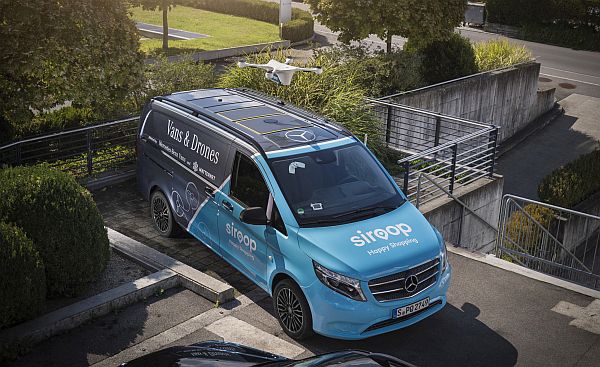Podcast: Play in new window | Download (Duration: 34:24 — 23.7MB)
A study examines sUAS collisions with manned aircraft, Amazon patents a self-disintegrating drone, Mercedes completes 100 package deliveries by drone, a race that pitted an autonomous drone against a piloted drone, and marine mammals are disturbed by drones.

Delivery drone above a Mercedes-Benz Vito van. Courtesy Daimler AG.
UAV News
Researchers Release Report on Drone Airborne Collisions
A research team from ASSURE {Alliance for System Safety of UAS through Research Excellence} released a report that looks at sUAS collisions with manned aircraft. Congress directed the FAA in 2014 to establish a UAS Center of Excellence and the FAA selected ASSURE, led by Mississippi State University, in May 2015.
The ASSURE UAS Airborne Collision Severity Evaluation Final Report concludes that drones that collide with large manned aircraft can cause more structural damage than birds of the same weight for a given impact speed. The FAA says they will use the research results to help develop operational and collision risk mitigation requirements for drones.
ASSURE used computer modeling and physical validation testing it its research. The team looked at a 2.7 pound quadcopter, a 4 pound quadcopter, a 4 pound fixed-wing drone, and an 8 pound fixed-wing drone, all striking a single-aisle commercial transport jet and a business jet.
They examined impacts to the wing leading edge, the windshield, and the vertical and horizontal stabilizers. The windshields generally sustained the least damage and the horizontal stabilizers suffered the most serious damage.
The researchers concluded that unmanned aircraft system manufacturers should adopt “detect and avoid” or “geo-fencing” capabilities to reduce the probability of collisions with other aircraft.
The ASSURE team provided an A3 Airborne Collision Presentation, and the report in four volumes:
FAA sUAS COE Task A3 UAS Airborne Collision Hazard Severity Evaluation [PDF]
An FAA press conference presentation explaining why it is necessary to determine the potential severity of sUAS mid-air collisions with aircraft in order to define an Equivalent Level of Safety to manned aviation.
Volume I: UAS Airborne Collision Severity Evaluation: Summary of Structural Evaluation [PDF]
A summary of the entire structural portion of the study that includes a high-level explanation of the project’s scope, technical approach, evaluation and conclusions of the severity of small unmanned aircraft impacts with a commercial transport jet and business jet. This summary report also provides conclusions on the influence of velocity and mass on impact damage, a comparison to bird strikes and concludes with recommendations going forward.
Volume II: UAS Airborne Collision Severity Evaluation: Quadcopter [PDF]
A detailed report the project’s scope and the selection and definition of both the “projectile” Unmanned Aircraft and the “target” commercial transport and business jets. This Volume centers on the quadcopter UAS and its unique characteristics.
Volume III: UAS Airborne Collision Severity Evaluation: Fixed-Wing UAS [PDF]
A similarly detailed report centering on the fixed-wing UAS and its unique characteristics.
Volume IV: UAS Airborne Collision Severity Evaluation: Engine Ingestion [PDF]
An evaluation of the severity of a small UAS collision with propulsion systems. This report helps us to start to understand the effects of parameters of aircraft speed, impact location, fan speed and unmanned aircraft orientation on impact severity to a unique FAA fan-blade-out model.
Amazon delivery drone could self-disintegrate for safety if it falls from sky
Amazon has been granted a patent for Directed fragmentation for unmanned airborne vehicles: “In one embodiment, the UAV includes various components, such one or more motors, batteries, sensors, a housing, casing or shell, and a payload for delivery. Additionally, the UAV includes a flight controller and a fragmentation controller. The flight controller determines a flight path and controls a flight operation of the UAV. During the flight operation, the fragmentation controller develops a fragmentation sequence for one or more of the components based on the flight path, the flight conditions, and terrain topology information, among other factors. The fragmentation controller can also detect a disruption in the flight operation of the UAV and, in response, direct fragmentation of one or more of the components apart from the UAV. In that way, a controlled, directed fragmentation of the UAV can be accomplished upon any disruption to the flight operation of the UAV.”
Mercedes Plans More Drone Deliveries After 100 Perfect Flights
In a 3-week pilot project by Mercedes-Benz Vans, US drone systems developer Matternet, and Swiss online marketplace siroop, 100 package delivery flights were successfully completed in Zurich. Customers placed orders for items like ground coffee and cellphones. The drones flew as far as 17 kilometers (11 miles) to four fixed points in the city where they landed on roofs of special Mercedes-Benz Vito vans. The vans then delivered the packages.
NASA-Built Drone Races FlyingBear, Loses
Professional drone racing pilot Ken “FlyingBear” Loo flew against a NASA autonomous drone. The NASA drone flew more cautiously, smoothly, and consistently over the course. Loo’s speeds were higher, and he executed more complex maneuvers, but mental fatigue became a factor. In the end, his times were quicker.
As Ocean Drones Proliferate Marine Wildlife are getting a bit annoyed
Drones are violating the Marine Mammal Protection Act of 1992 which makes it illegal to disturb marine mammals, regardless of whether you are in the water, in a boat, or in the air. Marine biologist Alicia Amerson started the AliMoSphere initiative to develop best practices studying marine wildlife with drones.
UAV Video of the Week
Flying Robot international Film Festival
The FRiFF calls itself “the world’s premiere international competitive short film festival focused on drone culture and aerial cinema created from the perspective of drones.”
The 2017 edition of the Festival took place November 16, 2017, at the Roxie Theater in San Francisco. Twenty-five short drone films from a dozen countries were selected for inclusion and nominated for awards in each of seven categories. Watch the winning drone films.
Mentioned
The Drone Racing League (DRL) and MultiGP Drone Racing Announce Simulator Partnership Surrounding the 2018 Swatch DRL Tryouts
